Although the career of Jean-Antoine Watteau (1684-1721) abruptly ended when he was still in his thirties, he left a permanent mark on the world of art.
He invented an entirely new genre called “Fêtes Galantes,” depictions of people having a good time in extremely theatrical parkland surroundings.
The idyllic settings of his paintings became the main source of inspiration for the Rococo artists who followed him in the 18th century, especially François Boucher and Jean-Honoré Fragonard.
His Rococo paintings were in turn inspired by the dramatic paintings of Baroque artists a century earlier. Especially paintings by Rubens which feature an exaggerated sense of motion inspired the French artist.
Watteau was a great fan of Italian comedy known as “Commedia dell’Arte” as well as ballet, two other sources of inspiration for the influential artist.
Let’s check out some of the most famous Jean-Antoine Watteau paintings.
1. The Embarkation for Cythera
- Date created: 1717
- Dimensions: 120 x 190 centimeters (50.7 x 76.3 inches)
- Location: Louvre Museum, Paris, France
The Embarkation for Cythera is a painting also known as “The Voyage to Cythera” or “Pilgrimage to the Isle of Cythera.” Depending on the interpretation of the work, it refers to a number of finely dressed aristocratic couples arriving or leaving the island of Cythera, a Greek island that was presumably the birthplace of the goddess Venus.
Venus is the goddess of love according to Greek mythology and Watteau used this subject to depict one of his famous “Fête Galante.” It’s one of the most famous Jean-Antoine Watteau paintings and served as his reception piece for the Royal Academy of Painting and Sculpture in Paris of which he became a member.
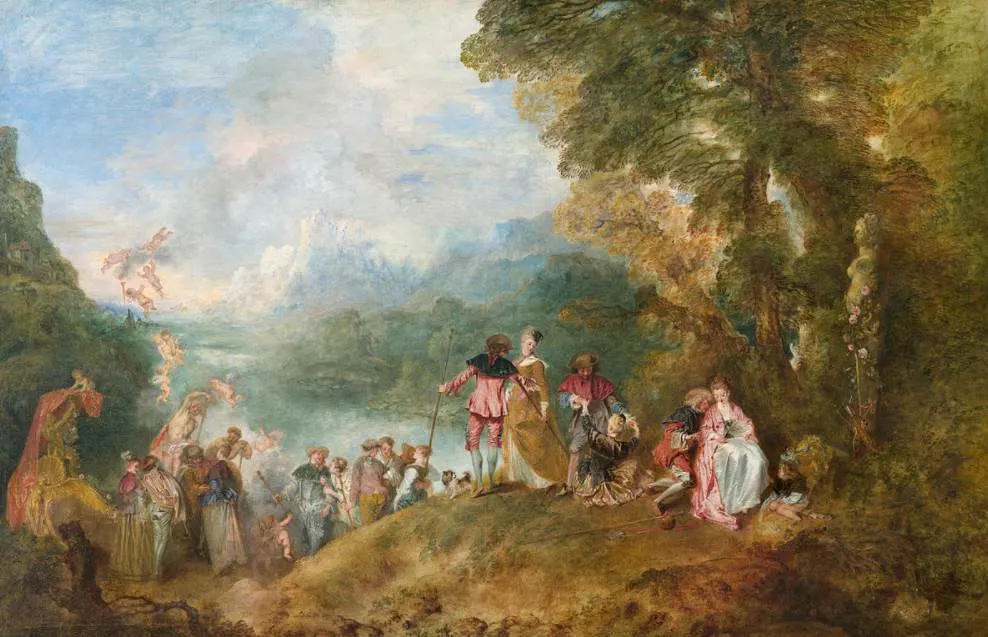
2. The Italian Comedians
- Date created: 1720
- Dimensions: 63.8 × 76.2 centimeters (25.12 × 30 inches)
- Location: National Gallery of Art, Washington D.C., United States
The Italian Comedians is one of Watteau’s paintings that perfectly depicts the fascination that the artist had for Italian comedy. We can see 15 actors of the commedia dell’arte theater who are dressed in the typical manner when they performed live on stage in the early 18th century.

The posture of some of the actors makes us assume that they are taking a bow shortly after they completed their performance. It’s very likely, however, that Watteau took some liberties in depicting the people on stage. They might or might not have been part of a particular play.
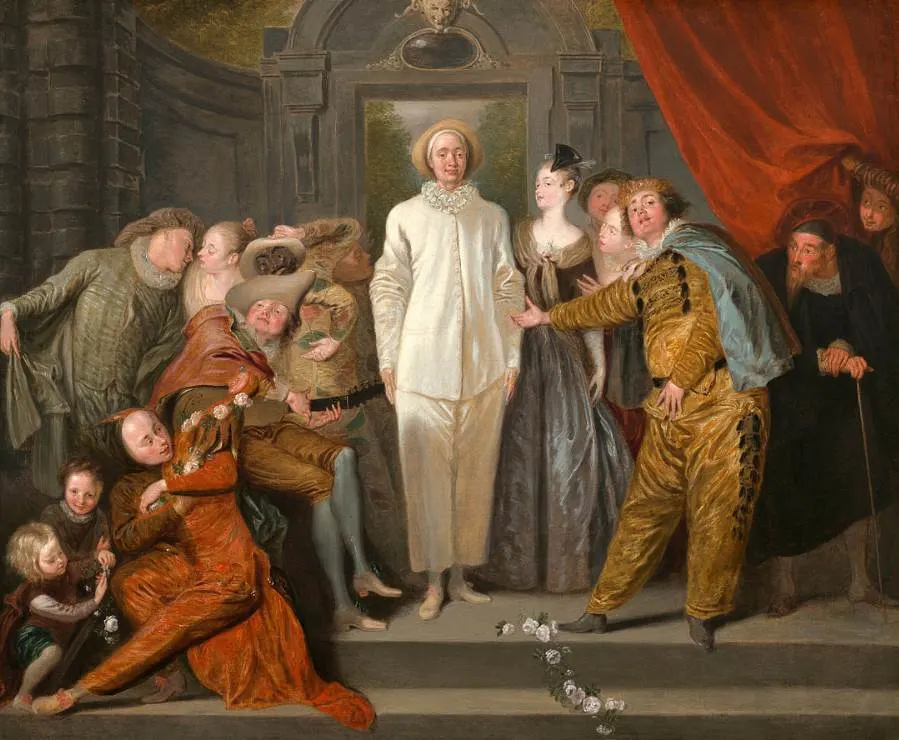
3. Les Plaisirs du Bal
- Date created: 1715-1717
- Dimensions: 52.5 x 65.2 centimeters (20.66 x 25.66 inches)
- Location: Dulwich Picture Gallery, London, United Kingdom
Les Plaisirs du Bal is another fascinating example of the Fêtes Galante genre that Jean-Antoine Watteau invented singlehandedly in the early 18th century. The artist was inspired but the paintings of Flemish artists in the 17th century, especially Ruben’s paintings such as. The garden of Love by Rubens is a prime example of this.
Just like the lavish party painted by Rubens near his castle during the final decade of his life, Watteau integrated a combination of a rural area with amazing architectural features. We can see a large number of people having a good time with a couple dancing the Minuet in the central part of the composition.
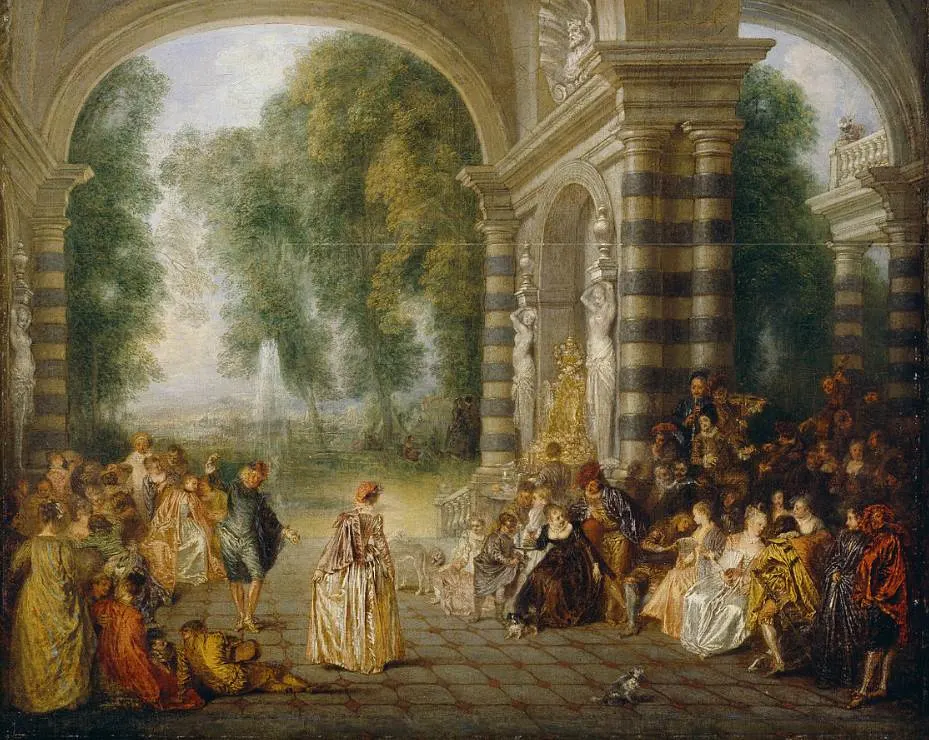
4. Fêtes Vénitiennes
- Date created: 1719
- Dimensions: 56 × 46 centimeters (22 × 18 inches)
- Location: Scottish National Gallery, Edinburgh, Scotland
Fêtes Vénitiennes is the title of a painting that was named as such because of the Venetian dresses worn by the women and the particular dance that is being performed. It wasn’t named as such initially because it only got its name after an engraving of it that was completed in 1732.
The exact details of the painting remain obscure although some art historians have suggested the names of the depicted people. The woman in the central part of the painting is possibly Charlotte Desmares, a Comédie-Française actress. The man wearing a black hat on the left is potentially Flemish painter Nicolas Vleughels, one of Watteau’s friends.
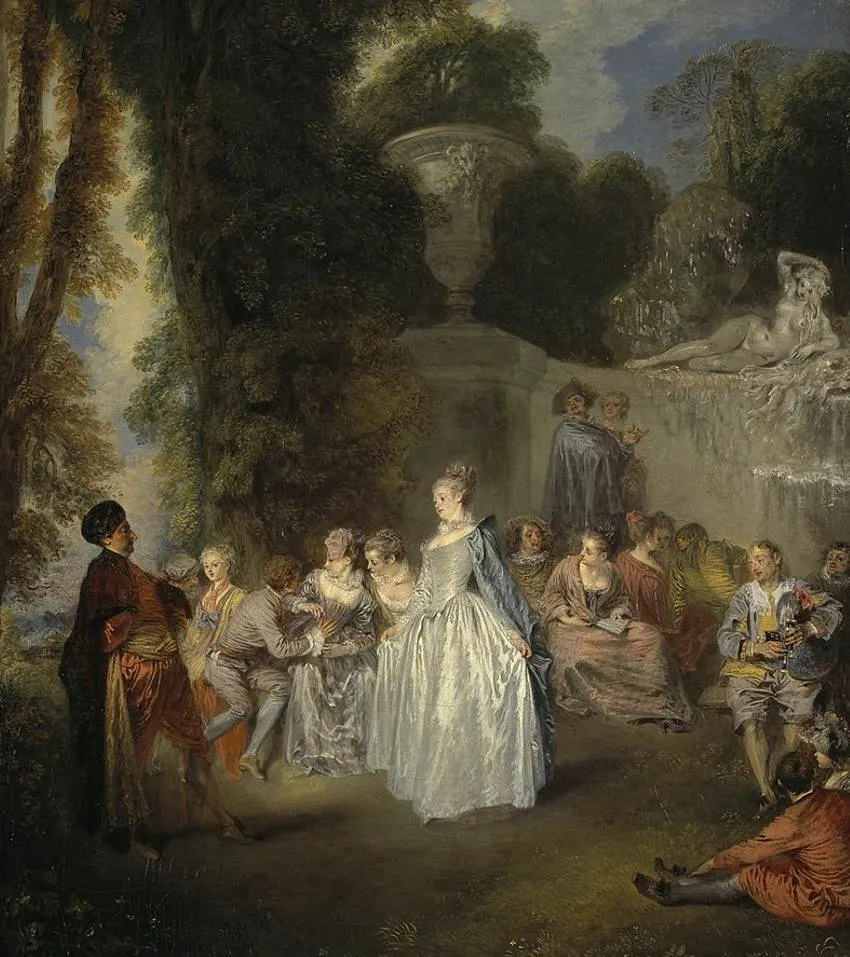
5. Pierrot
- Date created: 1718-1719
- Dimensions: 184.5 × 149.5 centimeters (72.6 × 58.9 inches)
- Location: Louvre Museum, Paris, France
Pierrot is a painting that depicts the main character of the commedia dell’arte theater. Pierrot was a naive clown, dressed in white satin, who tries to conquer the heart of Flaminia, the girl whom he craves for. His advances were rejected time in time again during the hilarious performances.
It’s fairly certain that Pierrot was the favorite subject of Watteau during these performances of the Italian theater group in Paris. He depicted Pierror multiple times in his works and places him much higher than the other characters in this distinctive painting.
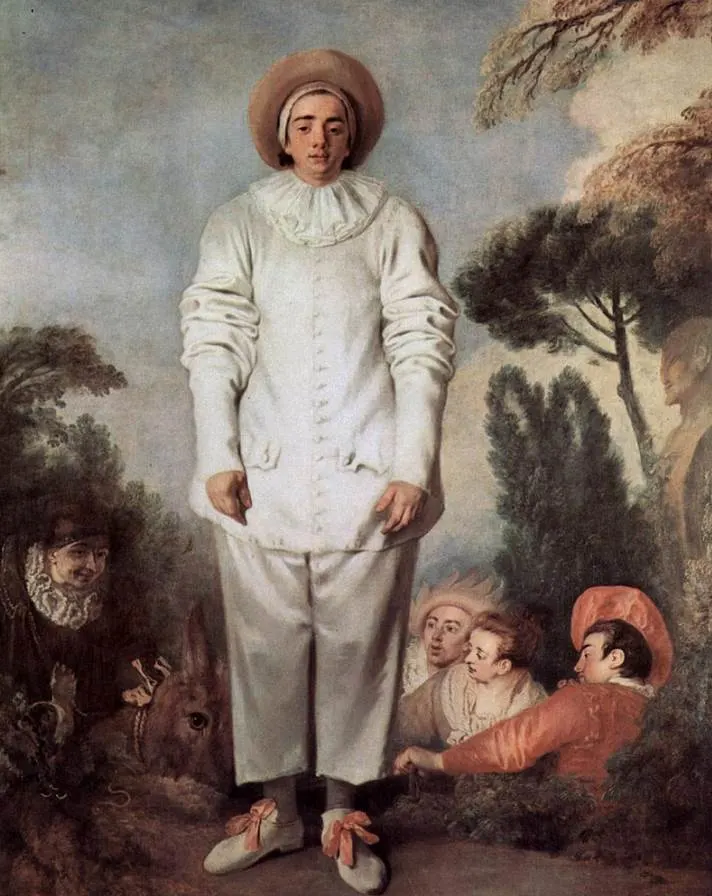
6. Actors of the Comédie-Française
- Date created: 1710s
- Dimensions: 20 × 25 centimeters (7.9 × 9.8 inches)
- Location: Hermitage Museum, Saint Petersburg, Russia
Actors of the Comédie-Française is a very small painting that is commonly known as “The Coquettes.” It remains uncertain when Watteau completed this painting but it’s fairly certain it was finished in the second decade of the 18th century.
Watteau combined the type of genre paintings of the theater he loved with portraiture, making this one of the most remarkable works in his oeuvre. The identity of the figures in this painting has been discussed for centuries. It’s generally accepted today that these depict contemporary actors of the French version of the theater that Watteau admired.
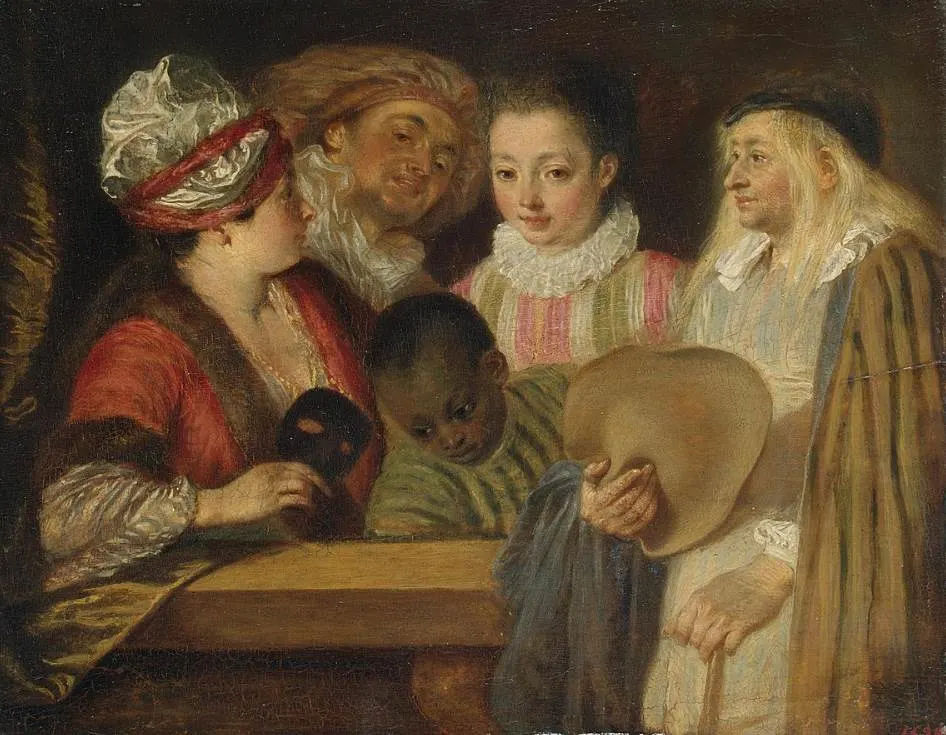
7. The Surprise
- Date created: 1718
- Dimensions: 36.3 x 28.2 centimeters (14.2 x 11.1 inches)
- Location: J. Paul Getty Museum, Los Angeles, United States
The Surprise is a painting that depicts Mezzetino, another character of the commedia dell’arte theater, while he is playing the guitar. He plays the guitar as a couple is embracing each other. A small dog is watching the entire scene in the bottom right corner.
This painting is believed to have been a pendant to another Watteau painting called “The Perfect Harmony, a work now part of the collection of the LACMA or Los Angeles County Museum of Art. Both works by the French artist are on display in museums just a few miles away from each other in Los Angeles.
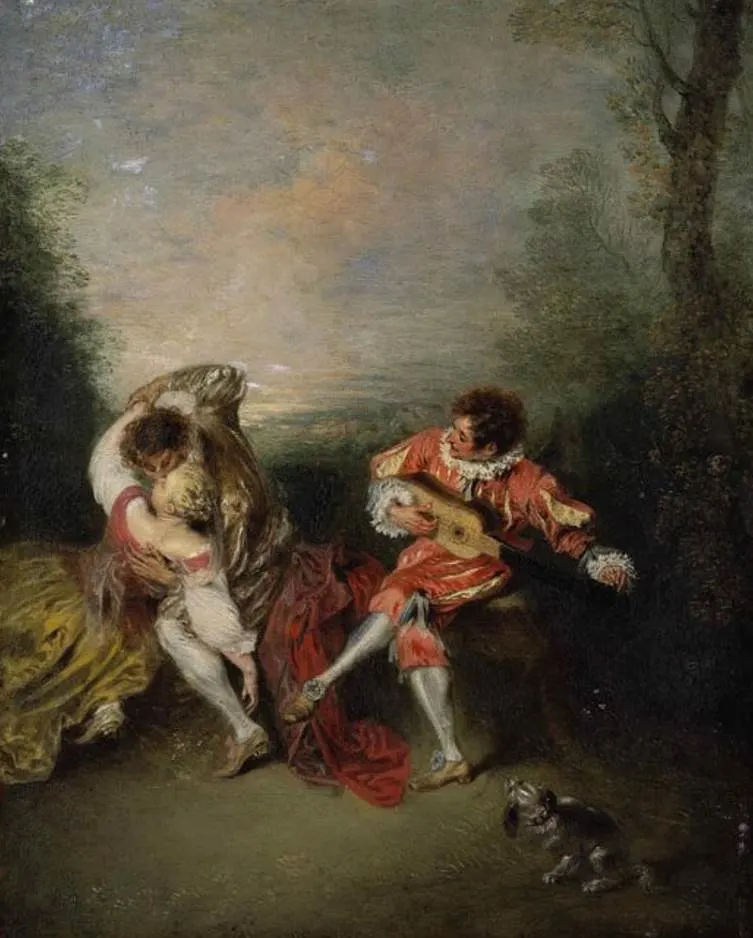
8. The Scale of Love
- Date created: 1717-1718
- Dimensions: 50.8 × 59.7 centimeters
- Location: National Gallery, London, United Kingdom
The Scale of Love is another painting that earned its title from a print that was produced several years after Watteau passed away. The idea of the title possibly reflects the scales of seduction in the game of love. The word scale might also reflect the skill needed to play this game.
The man wears a remarkable theatrical costume that wasn’t fashionable in Watteau’s time. The woman wears clothes that don’t fit into any particular time in history. The bust of a bearded man above the guitar player’s head probably represents Pythagoras. He was the man who discovered the musical scale based on mathematical principles.

9. Mezzetino
- Date created: 1718-1720
- Dimensions: 55.2 × 43.2 centimeters (21.7 × 17 inches)
- Location: MET Museum, New York City, United States
Mezzetino is a full-length portrait of the character in the commedia dell’arte theater. This character was based on harlequin, a comic servant character of this theater group. He did have his own distinctive costume and accompanied the other actors by playing the guitar.
The first actor who played this role was a man named Angelo Costantini. he had such an expressive face that he didn’t require a mask to play this role, a tradition that was kept alive for all successive actors. This painting was commissioned and owned by Jean de Jullienne, one of Watteau’s most notable patrons, and is now part of the collection of the Metropolitan Museum of Art in New York City.
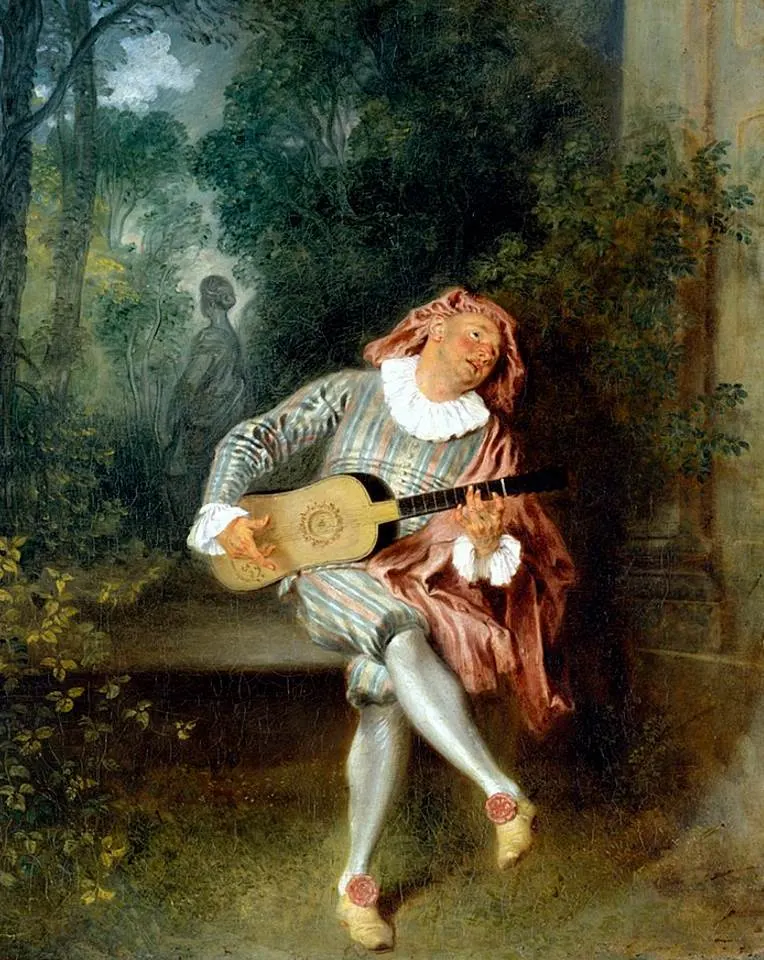
10. The Shop Sign of Gersaint
- Date created: 1720-1721
- Dimensions: 163 × 308 centimeters (64 × 121 inches)
- Location: Charlottenburg Palace, Berlin, Germany
The Shop Sign of Gersaint or L’Enseigne de Gersaint is believed to be the final major painting that Jean-Antoine Watteau worked on in his life. It was completed between 1720 and 1721 and was intended to serve as the stunning shop sign of an art dealer named Edme François Gersaint (1694-1750).
It’s by far the most ambiguous painting in the oeuvre of Watteau, and not just because of its monumental size. The artist made the shop much larger than it was in reality. The shop was located on the medieval Pont Notre-Dame in the heart of Paris. It never served as the sign of this shop and was purchased by Jean de Jullienne and subsequently Frederick the Great of Prussia in 1748.

